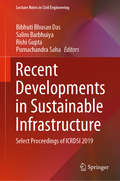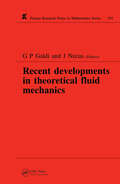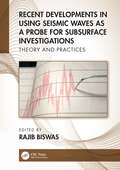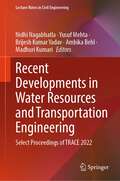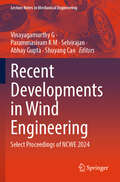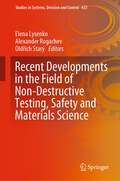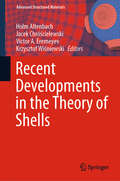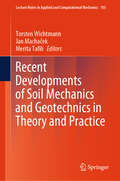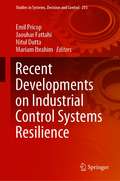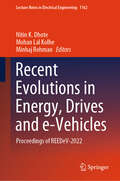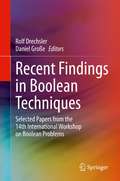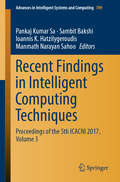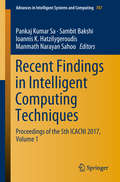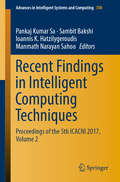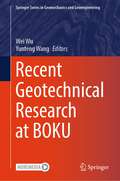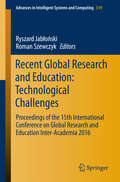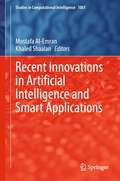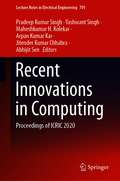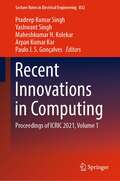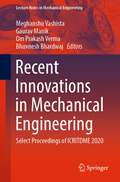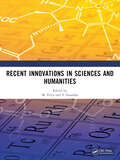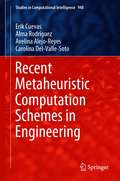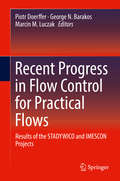- Table View
- List View
Recent Developments in Sustainable Infrastructure: Select Proceedings of ICRDSI 2019 (Lecture Notes in Civil Engineering #75)
by Bibhuti Bhusan Das Salim Barbhuiya Rishi Gupta Purnachandra SahaThis book comprises select peer-reviewed proceedings of the International Conference on Recent Developments in Sustainable Infrastructure (ICRDSI) 2019. The topics span over all major disciplines of civil engineering with regard to sustainable development of infrastructure and innovation in construction materials, especially concrete. The book covers numerical and analytical studies on various topics such as composite and sandwiched structures, green building, groundwater modeling, rainwater harvesting, soil dynamics, seismic resistance and control of structures, waste management, structural health monitoring, and geo-environmental engineering. This book will be useful for students, researchers and professionals working in sustainable technologies in civil engineering.
Recent Developments in Theoretical Fluid Mechanics: Winter School, Paseky, 1992
by J. Necas G P GaldiIncluding previously unpublished, original research material, this comprehensive book analyses topics of fundamental importance in theoretical fluid mechanics. The five papers appearing in this volume are centred around the mathematical theory of the Navier-Stokes equations (incompressible and compressible) and certain selected non-Newtonian modifications.
Recent Developments in Using Seismic Waves as a Probe for Subsurface Investigations: Theory and Practices
by Rajib BiswasSeismology has come a long way. Being the scientific study of seismic waves and their allied phenomena, it has entered a multidisciplinary realm. As the main tool, it provides a wealth of information when applied systematically to dig inside the Earth structure. Notwithstanding, the utility of seismic waves has increased manifold. Starting from knowing the epicenter of seismic events, it has influenced mapping of civil engineering structures such as dams and bridges, as well as huge constructions. Although there is no dearth of technical papers in the area of seismic waves, there is an absence of synchronized and recent coherent contents in the direction of seismic waves. The book will be a unique contribution to the field of seismology, with the aim of assimilating theory and practices. It will provide a comprehensive glimpse of recent advancements in this area with a strong unification of theory and practices. The main objective of the book is to present an in-depth analysis of the theory and real implementations of seismic waves as versatile probes that would be integrated with modern and future perspectives. The current and the future strategies to be discussed in the relevant areas of seismic waves will be another boon for readers. This book will cater to the needs of novices, researchers and practitioners. Additionally, the contents of the book will be useful for undergraduate as well as postgraduate students of earth science disciplines.
Recent Developments in Water Resources and Transportation Engineering: Select Proceedings of TRACE 2022 (Lecture Notes in Civil Engineering #353)
by Nidhi Nagabhatla Madhuri Kumari Yusuf Mehta Brijesh Kumar Yadav Ambika BehlThis book comprises select proceedings of the International Conference on Trends and Recent Advances in Civil Engineering (TRACE 2022). The book focuses on the latest research works carried out in the area of water resources and transportation engineering. Various topics covered in this book include technological intervention and solution for smart and sustainability in water resources and transportation infrastructure, crop protection, resilience to disaster like flood, hurricane, and drought, traffic congestion, transport planning, green and intelligent transportation infrastructure, etc. The book is useful to researchers and practitioners working in the areas of civil engineering, water resources, and transportation engineering.
Recent Developments in Wind Engineering: Select Proceedings of NCWE 2024 (Lecture Notes in Mechanical Engineering)
by Vinayagamurthy G Parammasivam K M Selvirajan Abhay Gupta Shuyang CaoThis book presents the select proceedings of the 10th National Conference on Wind Engineering (NCWE 2024). It broadly explores five major areas of research. The ‘testing methodologies’ section focuses particularly on the recent developments in wind tunnel testing, computational wind engineering and field measurements. It also delves into wind loading on structures, encompassing bridges, facades, chimneys, cooling towers, steel towers and low-rise and high-rise structures. The book also addresses revisions to the Indian Standard (IS) Codes The book has a dedicated chapter on measurements and assessments related to wind meteorology, wind climate assessment, urban wind environment, and disaster mitigation. It especially presents the recent advances in utilising Artificial intelligence (AI) and Machine Learning (ML) for predictions. This book also covers other important topics like wind-induced vibrations and control, specifically within aerodynamics and aeroelasticity. It also covers topics like wind turbines and other industrial aerodynamics, including vehicle and sports aerodynamics.
Recent Developments in the Field of Non-Destructive Testing, Safety and Materials Science (Studies in Systems, Decision and Control #433)
by Alexander Rogachev Oldřich Starý Elena LysenkoThis book presents the latest advances and emerging trends in research and industrial applications in non-destructive testing, manufacturing and process safety and diagnostics and materials science. With technological advances, the modern world is on the verge of a new industrial revolution, being in the stage of digital transformation, when innovations from different industries interpenetrate and complement each other. The School of Non-Destructive Testing, Tomsk Polytechnic University, Russia, promotes scientific research and industrial application of non-destructive testing and materials science technologies and related tests, as well as methods, to ensure safe manufacturing processes.Today, research and technology advancement is driven by innovations, and there is a need for publications to stimulate the formation and continuous training of specialists in non-destructive testing, materials science and safety. This book can be used as a complementary technical document to upgrade the skills of specialists in non-destructive testing, materials science and safety, and as a primary resource for training managers and decision-makers in various industries.Innovations in the fields of non-destructive testing, production and process safety, diagnostics and materials science and books that highlight the best and instructive are central to our technological world.I am pleased to see this comprehensive book taking shape and advancing this field to the next generation of scientists seeking for new research opportunities.
Recent Developments in the Theory of Shells (Advanced Structured Materials #110)
by Holm Altenbach Victor A. Eremeyev Jacek Chróścielewski Krzysztof WiśniewskiThis book commemorates the 80th birthday of Prof. W. Pietraszkiewicz, a prominent specialist in the field of general shell theory. Reflecting Prof. Pietraszkiewicz’s focus, the respective papers address a range of current problems in the theory of shells. In addition, they present other structural mechanics problems involving dimension-reduced models. Lastly, several applications are discussed, including material models for such dimension-reduced structures.
Recent Developments of Soil Mechanics and Geotechnics in Theory and Practice (Lecture Notes in Applied and Computational Mechanics #103)
by Torsten Wichtmann Jan Machaček Merita TafiliThis book provides essential insights into recent developments in fundamental geotechnical engineering research. Special emphasis is given to a new family of constitutive soil description methods, which take into account the recent loading history and the dilatancy effects. Particular attention is also paid to the numerical implementation of multi-phase material under dynamic loads, and to geotechnical installation processes. In turn, the book addresses implementation problems concerning large deformations in soils during piling operations or densification processes, and discusses the limitations of the respective methods. Numerical simulations of dynamic consolidation processes are presented in slope stability analysis under seismic excitation. Lastly, achieving the energy transition from conventional to renewable sources will call for geotechnical expertise. Consequently, the book explores and analyzes a selection of interesting problems involving the stability and serviceability ofsupporting structures, and provides new solutions approaches for practitioners and scientists in geotechnical engineering. The content reflects the outcomes of the Colloquium on Geotechnical Engineering 2024 (Geotechnik Kolloquium), held in Bochum, Germany in March 2024.
Recent Developments on Industrial Control Systems Resilience (Studies in Systems, Decision and Control #255)
by Emil Pricop Nitul Dutta Jaouhar Fattahi Mariam IbrahimThis book provides profound insights into industrial control system resilience, exploring fundamental and advanced topics and including practical examples and scenarios to support the theoretical approaches. It examines issues related to the safe operation of control systems, risk analysis and assessment, use of attack graphs to evaluate the resiliency of control systems, preventive maintenance, and malware detection and analysis. The book also discusses sensor networks and Internet of Things devices. Moreover, it covers timely responses to malicious attacks and hazardous situations, helping readers select the best approaches to handle such unwanted situations. The book is essential reading for engineers, researchers, and specialists addressing security and safety issues related to the implementation of modern industrial control systems. It is also a valuable resource for students interested in this area.
Recent Evolutions in Energy, Drives and e-Vehicles: Proceedings of REEDeV-2022 (Lecture Notes in Electrical Engineering #1162)
by Mohan Lal Kolhe Nitin K. Dhote Minhaj RehmanThis volume comprises the select peer reviewed proceedings of the International Conference on Recent Evolutions in Energy, Drives and e-Vehicles (REED-EV 2022). It aims to provide a comprehensive and broad-spectrum picture of the state-of-the-art research and development in the area of power and energy systems, grid integration, convertor topology, electrification for transport industries, battery storage and energy management systems, system protection, filters and harmonics, among others. This volume will provide a valuable resource for those in academia and industry.
Recent Findings in Boolean Techniques: Selected Papers from the 14th International Workshop on Boolean Problems
by Rolf Drechsler Daniel GroßeThis book describes recent findings in the domain of Boolean logic and Boolean algebra, covering application domains in circuit and system design, but also basic research in mathematics and theoretical computer science. Content includes invited chapters and a selection of the best papers presented at the 14th annual International Workshop on Boolean Problems.
Recent Findings in Intelligent Computing Techniques: Proceedings Of The 5th Icacni 2017, Volume 2 (Advances In Intelligent Systems and Computing #708)
by Pankaj Kumar Sa Manmath Narayan Sahoo Sambit Bakshi Ioannis K. HatzilygeroudisThis three volume book contains the Proceedings of 5th International Conference on Advanced Computing, Networking and Informatics (ICACNI 2017). The book focuses on the recent advancement of the broad areas of advanced computing, networking and informatics. It also includes novel approaches devised by researchers from across the globe. This book brings together academic scientists, professors, research scholars and students to share and disseminate information on knowledge and scientific research works related to computing, networking, and informatics to discuss the practical challenges encountered and the solutions adopted. The book also promotes translation of basic research into applied investigation and convert applied investigation into practice.
Recent Findings in Intelligent Computing Techniques: Proceedings Of The 5th Icacni 2017, Volume 2 (Advances In Intelligent Systems and Computing #708)
by Pankaj Kumar Sa Manmath Narayan Sahoo Sambit Bakshi Ioannis K. HatzilygeroudisThis three volume book contains the Proceedings of 5th International Conference on Advanced Computing, Networking and Informatics (ICACNI 2017). The book focuses on the recent advancement of the broad areas of advanced computing, networking and informatics. It also includes novel approaches devised by researchers from across the globe. This book brings together academic scientists, professors, research scholars and students to share and disseminate information on knowledge and scientific research works related to computing, networking, and informatics to discuss the practical challenges encountered and the solutions adopted. The book also promotes translation of basic research into applied investigation and convert applied investigation into practice.
Recent Findings in Intelligent Computing Techniques: Proceedings Of The 5th Icacni 2017, Volume 2 (Advances In Intelligent Systems and Computing #708)
by Pankaj Kumar Sa Manmath Narayan Sahoo Sambit Bakshi Ioannis K. HatzilygeroudisThis three volume book contains the Proceedings of 5th International Conference on Advanced Computing, Networking and Informatics (ICACNI 2017). The book focuses on the recent advancement of the broad areas of advanced computing, networking and informatics. It also includes novel approaches devised by researchers from across the globe. This book brings together academic scientists, professors, research scholars and students to share and disseminate information on knowledge and scientific research works related to computing, networking, and informatics to discuss the practical challenges encountered and the solutions adopted. The book also promotes translation of basic research into applied investigation and convert applied investigation into practice.
Recent Geotechnical Research at BOKU (Springer Series in Geomechanics and Geoengineering)
by Wei Wu Yunteng WangThis book offers a glimpse of the geotechnical research activities at BOKU, Vienna, in 2023. The research topics are wide-ranged including laboratory testing, constitutive modelling, numerical simulations with DEM and SPH, landslide, tunnelling and machine learning. Many research activities are carried out by visiting scholars from China.
Recent Global Research and Education: Technological Challenges
by Roman Szewczyk Ryszard JabłońskiDevelopments in the connected fields of solid state physics, bioengineering, mechatronics and nanometrology have had a profound effect on the emergence of modern technologies and their influence on our lives. In all of these fields, understanding and improving the basic underlying materials is of crucial importance for the development of systems and applications. The International Conference Inter-Academia 2016 has successfully married these fields and become a regular feature in the conference calendar. It consisted of seven thematic areas in the field of material science, nanotechnology, biotechnology, plasma physics, metrology, robotics, sensors and devices. The book Recent Global Research and Education: Technological Challenges is intended for use in academic, government and industry R&D departments, as an indispensable reference tool for the years to come. Also, we hope that the volume can serve the world community as the definitive reference source in Advances in Intelligent Systems and Computing. This book comprises carefully selected 68 contributions presented at the 15th International Conference on Global Research and Education INTER-ACADEMIA 2016, organized by Faculty of Mechatronics, Warsaw University of Technology, on September 26-28, in Warsaw, Poland. It is the second volume in series, following the edition in 2015. It brings together the knowledge and experience of 150 leading researchers representing 13 countries. We would like to thank all contributors and reviewers for helping us to put-together this book.
Recent Innovations in Artificial Intelligence and Smart Applications (Studies in Computational Intelligence #1061)
by Khaled Shaalan Mostafa Al-EmranThis book tackles the recent research trends on the role of AI in advancing automotive manufacturing, augmented reality, sustainable development in smart cities, telemedicine, and robotics. It sheds light on the recent AI innovations in classical machine learning, deep learning, Internet of Things (IoT), Blockchain, knowledge representation, knowledge management, big data, and natural language processing (NLP). The edited book covers empirical and reviews studies that primarily concentrate on the aforementioned issues, which would assist scholars in pursuing future research in the domain and identifying the possible future developments of AI applications.
Recent Innovations in Computing: Proceedings of ICRIC 2020 (Lecture Notes in Electrical Engineering #701)
by Arpan Kumar Kar Pradeep Kumar Singh Maheshkumar H. Kolekar Jitender Kumar Chhabra Yashwant Singh Abhijit SenThis book features selected papers presented at the 3rd International Conference on Recent Innovations in Computing (ICRIC 2020), held on 20–21 March 2020 at the Central University of Jammu, India, and organized by the university’s Department of Computer Science & Information Technology. It includes the latest research in the areas of software engineering, cloud computing, computer networks and Internet technologies, artificial intelligence, information security, database and distributed computing, and digital India.
Recent Innovations in Computing: Proceedings of ICRIC 2021, Volume 1 (Lecture Notes in Electrical Engineering #832)
by Arpan Kumar Kar Pradeep Kumar Singh Maheshkumar H. Kolekar Yashwant Singh Paulo J. S. GonçalvesThis book features selected papers presented at the 4th International Conference on Recent Innovations in Computing (ICRIC 2021), held on May 8–9, 2021, at the Central University of Jammu, India, and organized by the university’s Department of Computer Science and Information Technology. The book is divided into two volumes, and it includes the latest research in the areas of software engineering, cloud computing, computer networks and Internet technologies, artificial intelligence, information security, database and distributed computing, and digital India.
Recent Innovations in Computing: Proceedings of ICRIC 2021, Volume 2 (Lecture Notes in Electrical Engineering #855)
by Pradeep Kumar Singh Jitender Kumar Chhabra Yashwant Singh Zoltán Illés Chaman VermaThis book features selected papers presented at the 4th International Conference on Recent Innovations in Computing (ICRIC 2021), held on June 8–9, 2021 by Eötvös Loránd University (ELTE), Budapest, Hungary in association with many Universities; WSG Poland, Knowledge University, ERBIL. The book is divided into two volumes, and it includes the latest research in the areas of software engineering, cloud computing, computer networks and Internet technologies, artificial intelligence, information security, database and distributed computing, and digital India.
Recent Innovations in Mechanical Engineering: Select Proceedings of ICRITDME 2020 (Lecture Notes in Mechanical Engineering)
by Om Prakash Verma Gaurav Manik Meghanshu Vashista Bhuvnesh BhardwajThis book presents the select proceedings of the 3rd International Conference on Recent Innovations & Technological Development in Mechanical Engineering (ICRITDME 2020). It focuses on recent innovations and technological developments in the area of mechanical engineering to solve real-life problems occurring in different domains. Various topics covered in this book include machinery and machine elements, automotive engineering, aerospace technology and astronautics, nanotechnology and microengineering, control, robotics, mechatronics, dynamical systems, control, fluid mechanics engineering, thermodynamics, and heat and mass transfer. The book will be useful for students, researchers and professionals working in the area of mechanical engineering and allied fields.
Recent Innovations in Sciences and Humanities
by S. Anand M. Rishabha Priya V. Anandan H. Mary Henrietta S. VaralakshmiThe Conference covered a wide range of themes in various disciplines. In the field of English, the conference focused on digital tools in teaching and learning, the use of AI in language teaching and learning, literature in English language teaching, teacher training, and professional development, as well as linguistic competence in English language teachers.For those interested in mathematics, the conference explored topics such as computational methods for linear and non-linear optimization, mathematical models for computer science, numerical analysis, boundary value problems, real and complex analysis, probability and statistics, fluid dynamics, sequence spaces, mathematics education, applied mathematics, differential equations, and game theory.In the field of physics, the conference delved into materials science and engineering, functional materials, computational materials science, nanomaterials and nanotechnology, structural materials, photonic materials engineering, biomaterials, biomechanics, and biosensors.Lastly, in the field of chemistry, the conference discussed materials chemistry, composite, coating, and ceramic materials, soft matter and nanoscale materials, energy systems, and materials, functional thin-film materials, nanostructures and nanofilms, polymers and biopolymers, as well as surface science and engineering.
Recent Metaheuristic Computation Schemes in Engineering (Studies in Computational Intelligence #948)
by Erik Cuevas Alma Rodríguez Avelina Alejo-Reyes Carolina Del-Valle-SotoThis book includes two objectives. The first goal is to present advances and developments which have proved to be effective in their application to several complex problems. The second objective is to present the performance comparison of various metaheuristic techniques when they face complex optimization problems. The material has been compiled from a teaching perspective. Most of the problems in science, engineering, economics, and other areas can be translated as an optimization or a search problem. According to their characteristics, some problems can be simple that can be solved by traditional optimization methods based on mathematical analysis. However, most of the problems of practical importance in engineering represent complex scenarios so that they are very hard to be solved by using traditional approaches. Under such circumstances, metaheuristic has emerged as the best alternative to solve this kind of complex formulations. This book is primarily intended for undergraduate and postgraduate students. Engineers and application developers can also benefit from the book contents since it has been structured so that each chapter can be read independently from the others, and therefore, only potential interesting information can be quickly available for solving an industrial problem at hand.
Recent Progress in Desalination, Environmental and Marine Outfall Systems
by Mushtaque Ahmed Anton Purnama Mahad Baawain B. S. ChoudriThis book collects current scientific information on advanced technologies and management practices associated with the desalination industry in the Middle East and elsewhere around the world. The book opens with introductory chapter which briefly recounts the history of desalination, and describes the current state of development in the field. Part I: Desalination Systems includes ten chapters which describe a variety of techniques and designs intended not only to minimize the impact of desalination, but also to save energy and use natural resources to maximize the output of integrated desalination systems. Among the highlights are a chapter on the use of ceramic membrane technology for sustainable oil water production; a case study on the use of solar heating systems in desalination technology in Oman; discussion of fouling and its effect on design and performance of desalination systems; a review of shore approaches and sea-lines with case studies from Australia and Germany; and a discussion of the integration of desalination technology with renewable energy for climate change abatement in the Middle East and North Africa region. Part II: Environmental Systems includes among others a chapter on regulating the use of water resources and desalination technology on a regional scale reducing the carbon footprint of desalination, with examples from Australia; a description of desalination for irrigation in the Souss Massa region in the south of Morocco; a study of the impact of the coastal intake environment on operating conditions of thermal desalination plants in the United Arab Emirates; a discussion of hydrodynamic and thermal dispersion modeling of the effluent in a coastal channel, with a case study from Oman; and a mathematical model study of effluent disposal from a desalination plant in the marine environment at Tuticorin in India. The book aims to inspire developments in desalination technologies which are specifically aimed at reducing energy consumption and cost, and minimizing environmental impact.
Recent Progress in Flow Control for Practical Flows
by Piotr Doerffer George N. Barakos Marcin M. LuczakThis book explores the outcomes on flow control research activities carried out within the framework of two EU-funded projects focused on training-through-research of Marie Sklodowska-Curie doctoral students. The main goal of the projects described in this monograph is to assess the potential of the passive- and active-flow control methods for reduction of fuel consumption by a helicopter. The research scope encompasses the fields of structural dynamics, fluid flow dynamics, and actuators with control. Research featured in this volume demonstrates an experimental and numerical approach with a strong emphasis on the verification and validation of numerical models. The book is ideal for engineers, students, and researchers interested in the multidisciplinary field of flow control.
